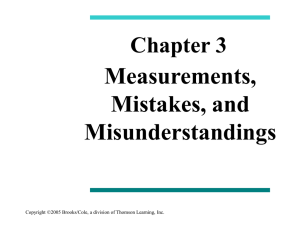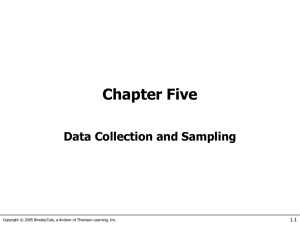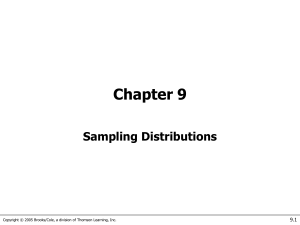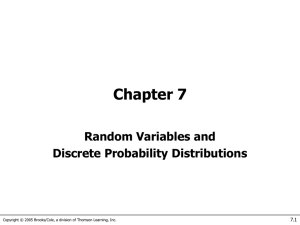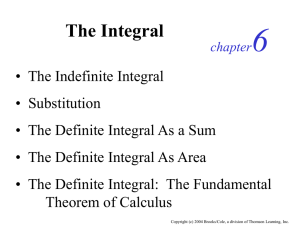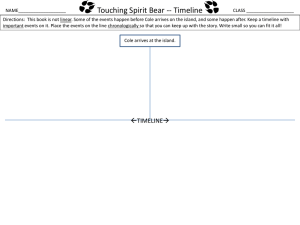random variable
advertisement
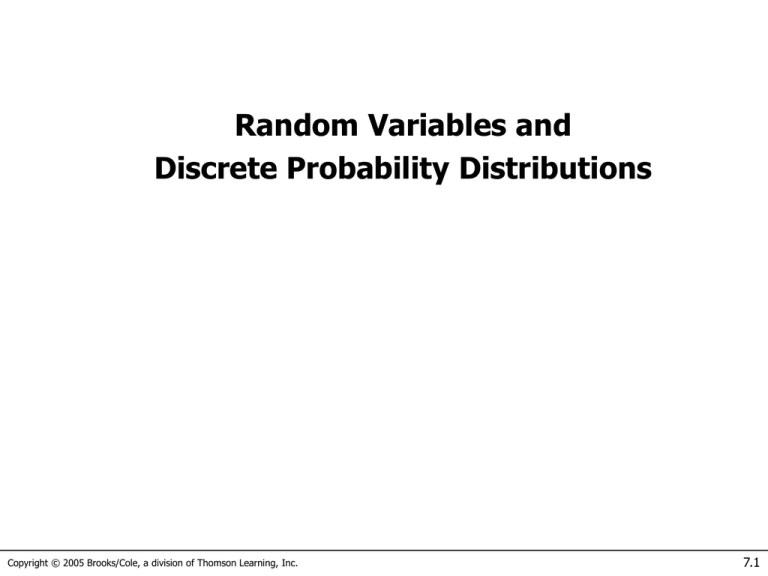
Random Variables and
Discrete Probability Distributions
Copyright © 2005 Brooks/Cole, a division of Thomson Learning, Inc.
7.1
Random Variables…
A random variable is a function or rule that assigns a
number to each outcome of an experiment. Basically it is just
a symbol that represents the outcome of an experiment.
X = number of heads when the experiment is flipping a coin
20 times.
C = the daily change in a stock price.
R = the number of miles per gallon you get on your auto
during a family vacation.
Y = the amount of medication in a blood pressure pill.
V = the speed of an auto registered on a radar detector used
on I-20
Copyright © 2005 Brooks/Cole, a division of Thomson Learning, Inc.
7.2
Two Types of Random Variables…
Discrete Random Variable – usually count data [Number of]
* one that takes on a countable number of values – this means you can sit
down and list all possible outcomes without missing any, although it might take you
an infinite amount of time.
X = values on the roll of two dice: X has to be either 2, 3, 4, …, or 12.
Y = number of accidents on the UTA campus during a week: Y has to be 0, 1, 2, 3,
4, 5, 6, 7, 8, ……………”real big number”
Continuous Random Variable – usually measurement data [time, weight, distance,
etc]
* one that takes on an uncountable number of values – this means you can
never list all possible outcomes even if you had an infinite amount of time.
X = time it takes you to drive home from class: X > 0, might be 30.1 minutes
measured to the nearest tenth but in reality the actual time is
30.10000001…………………. minutes?)
Exercise: try to list all possible numbers between 0 and 1.
Copyright © 2005 Brooks/Cole, a division of Thomson Learning, Inc.
7.3
Probability Distributions…
A probability distribution (density function) is a table,
formula, or graph that describes the values of a random
variable and the probability associated with these values.
– Discrete Probability Distribution
X = outcome of rolling one die
X
1 2 3 4 5 6
P(X) 1/6 1/6 1/6 1/6 1/6 1/6
– Continuous Probability Distribution
Copyright © 2005 Brooks/Cole, a division of Thomson Learning, Inc.
7.4
Discrete Probability Notation…
An upper-case letter will represent the name of the random
variable, usually X.
Its lower-case counterpart, x, will represent the value of the
random variable.
The probability that the random variable X will equal x is:
P(X = x) or more simply P(x)
X = number of heads in 10 flips of coin
P(X = 5) = P(5) = probability of 5 heads (x) in 10 flips
Copyright © 2005 Brooks/Cole, a division of Thomson Learning, Inc.
7.5
Discrete Probability Distributions…
Probabilities, P(x), associated with Discrete random
variables have the following properties.
X
1 2 3 4 5 6
P(X) 1/6 1/6 1/6 1/6 1/6 1/6
Copyright © 2005 Brooks/Cole, a division of Thomson Learning, Inc.
7.6
Developing Discrete Probability Distributions
Probability distributions can be estimated from relative
frequencies. Consider the discrete (countable) number of
televisions per household (X) from US survey data (Example
7.1)…
1,218 ÷ 101,501 = 0.012
e.g. P(X=4) = P(4) = 0.076 = 7.6%
Copyright © 2005 Brooks/Cole, a division of Thomson Learning, Inc.
7.7
Questions you might want answered
E.g. what is the probability there is at least one television but
no more than three in any given household?
“at least one television but no more than three”
P(1 ≤ X ≤ 3) = P(1) + P(2) + P(3) = .319 + .374 + .191 = .884
Copyright © 2005 Brooks/Cole, a division of Thomson Learning, Inc.
7.8
Example
In most college courses, you get as a grade, either an
A, B, C, D, or F. For credit purposes, A’s are
given 4 points, B’s are given 3 points, C’s are given 2
points, Ds are given 1 point, and F’s are no points.
Let X be the random variable representing the points a
student gets. What are the possible values of X?
The possible values of X are 4, 3, 2, 1, and 0.
Copyright © 2005 Brooks/Cole, a division of Thomson Learning, Inc.
7.9
Example
A college instructor teaching a large class traditionally gives
10% A’s, 20% B’s, 45% C’s, 15% D’s, and 10% F’s. If a student
is chosen at random from the class, the student’s grade on a 4point scale (A = 4) is a random variable X. Create the
distribution of X.
Value of X
P(X)
What is the probability that a student has a grade point of 3 or better in this
class?
What is the probability that a student has a grade point of 2 or worse in this
class?
Draw a probability histogram to picture the probability distribution of the
random variable X.
Copyright © 2005 Brooks/Cole, a division of Thomson Learning, Inc.
7.10
Discrete Probability Distribution
The mean of a discrete random variable is the weighted average of all
of its values. The weights are the probabilities. This parameter is also
called the expected value of X and is represented by E(X).
The variance is
The standard deviation is
Copyright © 2005 Brooks/Cole, a division of Thomson Learning, Inc.
7.11
Example
A college instructor teaching a large class traditionally gives
10% A’s, 20% B’s, 45% C’s, 15% D’s, and 10% F’s. If a student
is chosen at random from the class, the student’s grade on a 4point scale (A = 4) is a random variable X. Create the
distribution of X.
Value of X
0
1
2
3
4
P(X)
.10
.15
.45
.20
.10
Find the mean (expected value) and standard deviation for the probability
distribution.
Copyright © 2005 Brooks/Cole, a division of Thomson Learning, Inc.
7.12
Example
A fair coin is flipped 3 times. Find the mean and
standard deviation of the discrete random variable X
that counts the number of heads.
Copyright © 2005 Brooks/Cole, a division of Thomson Learning, Inc.
7.13
Example
The daily lottery costs $1 to play. You pick a 3 digit
number. If you win, you win $500. Find the expected
value and standard deviation of the lottery.
Copyright © 2005 Brooks/Cole, a division of Thomson Learning, Inc.
7.14
Example
Choose an American household at random and let the
random variable X be the number of persons living in
the household. Find the mean and standard deviation
of the average American household.
Copyright © 2005 Brooks/Cole, a division of Thomson Learning, Inc.
7.15
Computing Mean, Variance, and Std. Dev. for Discrete Random Variable
Mean = 1(.25) + 2(.32) + 3(.17) + 4(.15) + 5(.07) + 6(.03) + 7(.01)
= 2.6
Variance = (1-2.6)2*(.25) + (2-2.6)2*(.32) + . . . + (7-2.6)2*(.01)
= 8.78
Std. Dev. = SQRT(8.78) = 1.42
We are as smart as the goddess of statistics now, since we know the
true mean, variance, and standard deviation of the population.
Copyright © 2005 Brooks/Cole, a division of Thomson Learning, Inc.
7.16
Rules for means
Example: You play two casino games. Game 1 has an expectation of losing $1 a
play and game 2 has an expectation of losing $2 a play. If you play both games,
what is your expectation for both games.
Example: You go to a casino and play the same slot machine which averages losing
15 cents a play. You play the machine 100 times and then leave, paying $5 for
parking. Find your expectation for your casino visit.
Copyright © 2005 Brooks/Cole, a division of Thomson Learning, Inc.
7.17
Rules for Variances of Random Variables
Example: Suppose two pro bowlers Adam (A) and Bart (B) have the
following distribution of scores.
Copyright © 2005 Brooks/Cole, a division of Thomson Learning, Inc.
7.18
Example
Depending on the attendance of a minor league baseball team,
the number of hot dogs and sodas sold at a game is given by
the following table.
Find the standard deviation of the number of hot dogs plus the
number of sodas sold.
Copyright © 2005 Brooks/Cole, a division of Thomson Learning, Inc.
7.19
Example: You weight all 30,000 students
Random Variable: X = students weight
Mean(X) = X-Bar = 160 lbs
Variance(X) = s2 = 900 lbs2
StdDev(X) = s = 30 lbs
*************************************
You now discover that the scales reported a student’s
weight 5 lbs too heavy. The student’s real weights (Y)
should have been Y = X – 5. What are the mean and
variance of the student’s REAL weights
Mean(Y) = Mean(X) – 5 = 160 – 5 = 155 lbs
Variance(Y) = Variance(X) = 900
StdDev(Y) = SQRT(900) = 30
Copyright © 2005 Brooks/Cole, a division of Thomson Learning, Inc.
7.20
Example: You measure the height of all 30,000 students
Random Variable: X = students height in “Feet”
Mean(X) = X-Bar = 5.8 feet
Variance(X) = s2 = 0.09 feet2
StdDev(X) = s = 0.3 feet
*************************************
You now discover that the President wanted to measure student’s
heights in “Inches” and not “Feet”. The student’s height in “Inches”
(Y) should have been Y = 12*X . What are the mean and variance of
the student’s heights in Inches?
Mean(Y) = 12*Mean(X) = 12*5.8 = 69.6 inches
Variance(Y) = 122*Variance(X) = 144*(.09) = 12.96
StdDev(Y) = SQRT(12.96) = 3.6
Copyright © 2005 Brooks/Cole, a division of Thomson Learning, Inc.
7.21
Laws…
We can derive laws of expected value and variance for the sum of two independent
random variables as follows…
E(X + Y) = E(X) + E(Y)
V(X + Y) = V(X) + V(Y)
**************************************************************
X = weight of right shoes: Mean(X) = .5 lbs and Var(X) = .0004
Y = weight of left shoes: Mean(Y) = .5 lbs and Var(Y) = .0004
**************************************************************
What is the mean and variance of a “Pair” of shoes. P = X +Y
E(P) = E(X + Y) = E(X) + E(Y) = .5 + .5 = 1.0
V(P) = V(X+Y) = V(X) + V(Y) = .0004 + .0004 = .0008
NOTE: WEIGHTS OF RIGHT AND LEFT SHOE INDEPENDENT
***************************************************************
? How could you determine the mean and variance of the weight of
an automobile after you make all the parts but before you
assemble the automobile
Copyright © 2005 Brooks/Cole, a division of Thomson Learning, Inc.
7.22
Binomial Distribution… 2 parameters [n and p]
The binomial distribution is the probability distribution that
results from doing a “binomial experiment”. Binomial
experiments have the following properties:
1. Fixed number of trials, represented as n.
2. Each trial has two possible outcomes, a “success” and a
“failure”.
3. P(success)=p (and thus: P(failure)=1–p), for all trials.
4. The trials are independent, which means that the
outcome of one trial does not affect the outcomes of any
other trials.
Copyright © 2005 Brooks/Cole, a division of Thomson Learning, Inc.
7.23
Success and Failure…
…are just labels for a binomial experiment, there is no value
judgment implied. You may define either one of the 2
possible outcomes as “Success”
For example a coin flip will result in either heads or tails. If
we define “heads” as success then necessarily “tails” is
considered a failure (inasmuch as we attempting to have the
coin lands heads up).
Other potential examples of binomial random variables:
– A firecracker pops or fails to pop
– A patient get an infection during an operation or does not get an
infection
Copyright © 2005 Brooks/Cole, a division of Thomson Learning, Inc.
7.24
Binomial Random Variable…
The random variable of a binomial experiment is defined as the
number of successes, X, in the n trials, where the probability of
success on a single trial is p.
E.g. flip a fair coin 10 times…
1) Fixed number of trials n=10
2) Each trial has two possible outcomes {heads (success), tails (failure)}
3) P(success)= 0.50; P(failure)=1–0.50 = 0.50
4) The trials are independent (i.e. the outcome of heads on the first flip will
have no impact on subsequent coin flips).
Hence flipping a coin ten times is a binomial experiment since all
conditions were met.
Copyright © 2005 Brooks/Cole, a division of Thomson Learning, Inc.
7.25
Are these examples of binomial distributions?
1) Tossing 20 coins and counting the number of heads.
1) Success is a heads, failure is a tails.
2) n = 20
3) Independence is true – coins have no influence on each other
4) p = .5.
So X is B(20, .5). The possible values of X are the integers from 0 to 20.
2) Picking 5 cards from a standard deck and counting the number of hearts.
We replace the card each time and reshuffle.
1) Success is a heart, failure is anything but a heart.
2) n = 5.
3) Independence is true.
4) p =.25.
So X is B(5, .25). The possible values of X are the integers from 0 to 5.
Copyright © 2005 Brooks/Cole, a division of Thomson Learning, Inc.
7.26
Are these examples of binomial distributions?
3) Picking 5 cards from a standard deck and counting the number of hearts
without reshuffling.
This is not binomial because of the independence issue.
4) Choosing a card from a standard deck until you get a heart.
This is not binomial as there are not a fixed number of observations.
5) It is estimated that 87% of computers users use Explorer as their default
web browser. We choose 50 computer users and ask their default browser.
1) Success is Explorer, failure is anything else.
2) n =50.
3) Independence seems logical.
4) p = .87.
So X is B(50, .87). The possible values of X are the integers from 0 to 50.
Copyright © 2005 Brooks/Cole, a division of Thomson Learning, Inc.
7.27
Binomial Distribution [formula]
The binomial random variable (# of successes in n trials) take
on values 0, 1, 2, …, n. Thus, its a discrete random variable.
Once we know a random variable is binomial, we can
calculate the probability associated with each value of the
random variable from the binomial distribution:
n!
n Ck
k ! n k !
where n = number in sample p = probability of success
k = # successes and n-k = # failures
Copyright © 2005 Brooks/Cole, a division of Thomson Learning, Inc.
7.28
Problem: Pat Statsdud…
Pat Statsdud failed to study for the next stat exam. Pat’s
exam strategy is to rely on luck for the next quiz. The quiz
consists of 10 multiple-choice questions (n=10). Each
question has five possible answers, only one of which is
correct (p=0.2). Pat plans to guess the answer to each
question.
What is the probability that Pat gets no answers correct?
P(X=0) = P(0) =
What is the probability that Pat gets two answers correct?
P(X=2) = P(2) =
Copyright © 2005 Brooks/Cole, a division of Thomson Learning, Inc.
7.29
Pat Statsdud…
n=10, and P(success) = .20
What is the probability that Pat gets no answers correct?
I.e. # success, x, = 0; hence we want to know P(x=0)
Pat has about an 11% chance of getting no answers correct
using the guessing strategy.
Copyright © 2005 Brooks/Cole, a division of Thomson Learning, Inc.
7.30
Pat Statsdud…
n=10, and P(success) = .20
What is the probability that Pat gets two answers correct?
I.e. # success, x, = 2; hence we want to know P(x=2)
Pat has about a 30% chance of getting exactly two answers
correct using the guessing strategy.
Copyright © 2005 Brooks/Cole, a division of Thomson Learning, Inc.
7.31
Example
You toss 5 coins. What is the probability that you get 3
heads?
n k
P( X k ) p (1 p) nk
k
Copyright © 2005 Brooks/Cole, a division of Thomson Learning, Inc.
7.32
Cumulative Probability…
“Find the probability that Pat fails the quiz”
If a grade on the quiz is less than 50% (i.e. 5 questions
out of 10), that’s considered a failed quiz.
P(fail quiz) = P(X < 4) = P(0)+P(1)+P(2)+P(3)+P(4)
Called a cumulative probability, that is, P(X ≤ x)
Note: Calculating all these individual probabilities would be tedious
and time consuming, however, the Binomial tables at back of book
gives you the cumulative probabilities [n=10, p=0.2, x=4]
Copyright © 2005 Brooks/Cole, a division of Thomson Learning, Inc.
7.33
Pat Statsdud…
Calculate Individual Probabilities and Add Up!
P(X ≤ 4) = P(0) + P(1) + P(2) + P(3) + P(4)
We already know P(0) = .1074 and P(2) = .3020. Using the binomial
formula to calculate the others:
P(1) = .2684 , P(3) = .2013, and P(4) = .0881
Hense P(X ≤ 4) = .1074 + .2684 + … + .0881 = .9672
OR
Use binomial tables at back of book for n=10, p=0.2, and x=4
OR
Use CALCULATOR!
Copyright © 2005 Brooks/Cole, a division of Thomson Learning, Inc.
7.34
Calculator
binompdf(number of trials, probability of success, number of success)
Used to compute binomial probabilities for a
particular number of successes.
binomcdf(number of trials, probability, number of successes or less)
Used to compute cumulative (from smaller)
successes.
Copyright © 2005 Brooks/Cole, a division of Thomson Learning, Inc.
7.35
Example
Will Guess takes a true-false test of 6 questions and has
absolutely no idea of any of the answers.
So, true to his name, he guesses on all of them. If 4 questions
correct is passing, what is the probability that he passes the
exam?
Suppose the test above is now multiple choice with 4 answers
per problem and again, Will Guesses.
Find the probability that he passes the test and the expected
number of passing students in a school of 1,500 if
they all guessed.
Copyright © 2005 Brooks/Cole, a division of Thomson Learning, Inc.
7.36
Example
In a particular city, 63% of the adults own their home
and 37% rent. A sample of 20 adults is taken.
Find the probability that the sample will have at least
half home-owners.
Copyright © 2005 Brooks/Cole, a division of Thomson Learning, Inc.
7.37
Binomial Distribution…
As you might expect, statisticians have determined formulas
for the mean, variance, and standard deviation of a binomial
random variable. They are:
Previous example: n=10, p=0.2
μ = n*p = 10*0.2 = 2
σ2 = n*p*(1-p) = 10*0.2*0.8= 1.6
σ = SQRT(1.6) = 1.26
Copyright © 2005 Brooks/Cole, a division of Thomson Learning, Inc.
7.38
Example
A basketball player is traditionally a 72% foul shooter.
In a season, he takes 427 foul shots. Find
the mean and standard deviation of the distribution.
Copyright © 2005 Brooks/Cole, a division of Thomson Learning, Inc.
7.39
Geometric Random Variables
Only two possible outcomes (success or failure)
Probability of success is constant for each trial
Each trial is independent of other trials
Looking for the number of trials to obtain the FIRST
success
Copyright © 2005 Brooks/Cole, a division of Thomson Learning, Inc.
7.40
Geometric Distributions
Geometric distributions: probability distribution of a
geometric random variable (all possible outcomes of X
before the first success is seen and their possibilities)
P(x = n) = (1 - p)n-1 p
You roll two dice and add them. Find the probability that we roll a
7 on the first trial, the second, the third, the 4th, and the 5th.
Trial #
P(7) =
1
2
3
4
5
P(x)
Copyright © 2005 Brooks/Cole, a division of Thomson Learning, Inc.
7.41
Calculator
geometpdf(probability of success, number of trials)
Use for computing geom. probabilities for a particular
number of trials.
geometcdf (probability of success, number of trials)
Use for computing geom. probabilities of a given
number of trials or less (cumulative from smaller
end)
Copyright © 2005 Brooks/Cole, a division of Thomson Learning, Inc.
7.42
Example
It is estimated that 45% of people in Fast-Food
restaurants order a diet drink with their lunch.
Find the probability that the fourth person orders a diet
drink.
Also find the probability that the first diet
drinker of the day occurs before the 5th person.
Copyright © 2005 Brooks/Cole, a division of Thomson Learning, Inc.
7.43
Mean and Standard deviational
Mean of geometric random variable X:
1
X
p
Standard deviation of geometric random variable X:
1 p
X
p2
In New York City at rush hour, the chance that a taxicab passes someone
and is available is 15%.
a) How many cabs can you expect to pass you for you to find one that is
free?
b) What is the probability that more than 10 cabs pass you before you
find one that is free?
Copyright © 2005 Brooks/Cole, a division of Thomson Learning, Inc.
7.44
Copyright © 2005 Brooks/Cole, a division of Thomson Learning, Inc.
7.45
Poisson Distribution… 1 parameter [μ]
Named for Simeon Poisson, the Poisson distribution is a
discrete probability distribution and refers to the number of
events (a.k.a. successes) within a specific time period or
region of space. For example:
• The number of cars arriving at a service station in 1 hour. (The
interval of time is 1 hour.)
• The number of flaws in a bolt of cloth. (The specific region is a
bolt of cloth.)
• The number of accidents in 1 day on a particular stretch of
highway. (The interval is defined by both time, 1 day, and space,
the particular stretch of highway.)
Copyright © 2005 Brooks/Cole, a division of Thomson Learning, Inc.
7.46
Poisson Probability Distribution…
The probability that a Poisson random variable assumes a
value of x is given by:
Note: μ is the only parameter [tell me μ and I can calculate
the probabilities]
and e is the natural logarithm base.
FYI:
Copyright © 2005 Brooks/Cole, a division of Thomson Learning, Inc.
7.47
Example 7.12…
The number of typographical errors in new editions of
textbooks varies considerably from book to book. After
some analysis he concludes that the number of errors is
Poisson distributed with a mean of 1.5 typos per 100 pages.
The instructor randomly selects 100 pages of a new book.
What is the probability that there are no typos?
That is, what is P(X=0) given that
= 1.5?
“There is about a 22% chance of finding zero errors”
Copyright © 2005 Brooks/Cole, a division of Thomson Learning, Inc.
7.48
Poisson Distribution…
As mentioned on the Poisson experiment slide:
The probability of a success is proportional to the size of
the interval
Thus, knowing an error rate of 1.5 typos per 100 pages, we
can determine a mean value for a 400 page book as:
=1.5(4) = 6 typos / 400 pages.
Copyright © 2005 Brooks/Cole, a division of Thomson Learning, Inc.
7.49
Example 7.13…
For a 400 page book, what is the probability that there are
no typos?
P(X=0) =
“there is a very small chance there are no typos”
Copyright © 2005 Brooks/Cole, a division of Thomson Learning, Inc.
7.50
Example 7.13…
For a 400 page book, what is the probability that there are
five or less typos?
P(X≤5) = P(0) + P(1) + … + P(5)
This is rather tedious to solve manually. A better alternative
is to refer to Table 2 in Appendix B…
…k=5,
=6, and P(X ≤ k) = .446
“there is about a 45% chance there are 5 or less typos”
Copyright © 2005 Brooks/Cole, a division of Thomson Learning, Inc.
7.51
Example 7.13…
…Excel is an even better alternative:
Copyright © 2005 Brooks/Cole, a division of Thomson Learning, Inc.
7.52
Poisson Practice
The number of infections [X] in a hospital each week has
been shown to follow a poisson distribution with mean 3.0
infections per week. Calculate the following probabilities.
•P(X = 0) =
•P(X < 4) =
•P(X > 9) =
•If you found 9 infections next week, what would you say??
Copyright © 2005 Brooks/Cole, a division of Thomson Learning, Inc.
7.53
